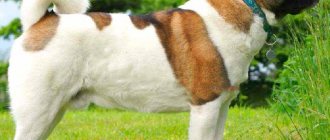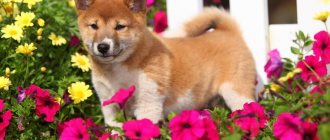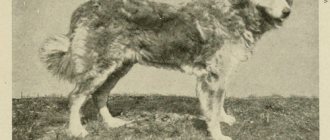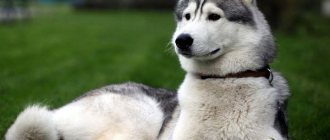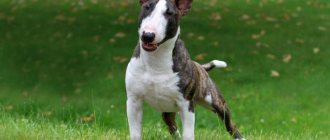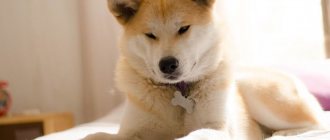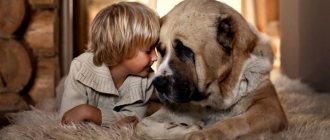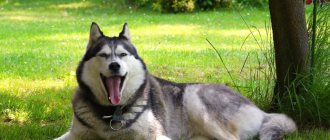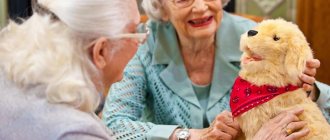Character
The character of the Akita Inu is almost completely free of negative qualities.
With a stretch, this includes insatiable curiosity. Dogs must know about every little thing that happens (or appears in the apartment). The pet will constantly “get underfoot”, will be the first to check any bags brought, and will react to the slightest movement. Akita Inu puppies are very cheerful, playful, love to play mischief, but do not show aggression. Psychologically, they mature quite late (closer to two years). Gradually the character of dogs changes. With age, restraint, calmness, and the dignity of a true aristocrat appear in him. At first glance, it seems that the Akita Inu is self-sufficient and does not need society - this is a mistaken opinion. Behind the mask of equanimity is hidden a very gentle, impressionable creature who requires the love and affection of those around her.
Akita Inu likes to carry objects in its teeth. They will be happy to bring slippers or a leash before a walk. They can grab you by the wrist or pull - this way the dog does not attack, but demands attention to itself.
There are some cat habits in the behavior of dogs. For example, they love to lick their fur. The manner of attack is also different: the “Japanese” track down a potential enemy, crouching to the ground, choosing the right moment, silently rushing at the prey. They do not bark often, but they make a wide variety of sounds, reminiscent of snorting, grunting, moaning and others.
Dogs adore all family members, but only as long as they are treated with respect.
It is important to remember that Japanese dogs are extremely touchy and rarely forgive a bad attitude or rudeness towards themselves. Kindness will be responded to with unquestioning obedience and meekness.
Animals are absolutely not prone to mischief. They will not chew shoes or damage furniture in the house.
General characteristics of the breed
The main features that we observe at the present time, the Ainu acquired as a result of evolution, during the period when they performed complex work, helping people.
The Ainu were distinguished by excellent endurance and devotion to their master, and worked equally with him.
Externally, the Hokkaido dog has something similar to the equally popular breeds of Japanese dogs, such as Akita Inu or Shiba Inu.
The height of these dogs is about 50 cm, and their weight does not exceed 30 kg.
Despite some similarities with the above-mentioned breeds, the Ainu dog breed has a unique, personal appearance.
Dogs of this breed have very thick hair, which is soft. The Ainu coat has protective properties, allowing it to repel moisture and dirt, therefore, the dog does not need frequent bathing.
Thick coat allows the dog to easily tolerate extreme heat or cold.
Hokkaido has a lot of colors, and they are presented with both light and dark coats.
The emergence of a nursery in Osaka
Nakagawa became interested in Akita dogs 55 years ago, when he was 29 years old. After graduating from school in the prefecture. Kagawa, where he was born and raised, he went to work on a cargo ship that carried cargo abroad, and then moved into the house of his older sister, where she lived with her husband. My brother-in-law loved dogs very much and kept different breeds, including Akita and Shiba. While caring for them, Nakagawa also became interested in them and started his own breeding and selling business. In the name "Nakagawa Chikukenten" the part chikuken, "dog breeding", is not heard in modern speech, and this is one evidence that the kennel opened before the words petto seppu (pet shop) or burida ( breeder, "breeder").
At first he sold both shepherd dogs and spitz dogs, but then he decided to keep only Akitas. Having become skilled in handling dogs, he traveled all over the country and became one of the most famous Akita handlers in Japan, that is, specialists who show dogs at exhibitions, trying to bring out their best sides.
Nakagawa Jitaro kept different dogs, and is sure that Akitas are the best
In 1974, he was elected chairman of the Japanese Akita Dog Breeders Society, and in 1976 he joined the certification commission of this society. In 1987-1988, he was the head of the Akita division of the Japan Kennel Club Foundation, a member of the International Canine Federation. Since then, he has established connections with canine organizations in the US and UK, and began to receive orders from abroad.
Appearance of the Hokkaido breed
The dogs of this Japanese breed are very similar to their fellow countrymen - the large Akita and the small Shiba. Ainu is somewhere between them in size. The height of males is 48-51 cm, weight no more than 30 kg. Bitches are much smaller.
The Hokkaido are proportionally built and solidly built, their figure fitting into a square format. Dogs have strong bones and developed muscles.
The Ainu head has a wide forehead and a noticeable stop. The straight, wedge-shaped muzzle ends in a black lobe (pink or brown in white dogs). Lips with black pigmentation, jaws strong with a scissor bite. Cheeks are well developed. Dark brown small eyes are widely spaced. The dog looks as if gloomily, with a peculiar cunning squint. The ears are triangular in shape, small, raised and slightly directed forward.
The neck of a Hokkaido dog is muscular, the back is of medium width and straight. The chest is quite wide and deep, the stomach is tucked. The thick tail is set high and carried over the back. It is twisted in the shape of a donut or curved like a sickle. When spread, the tail should reach the hocks. Limbs are straight and strong. Paws with hard and elastic pads and dark nails.
Ainu dogs move quickly, easily and springily. They are very active.
The outer coat is straight and harsh, the undercoat is much softer. The hair on the tail is much longer than on the body. The standard provides for several types of colors for the Ainu breed: black (including with tan), white, sesame (red-fawn hair with black at the end), brindle, red.
More or less serious exterior defects include any deviations from the breed standard, as well as minor problems with the bite.
The reasons for disqualifying a dog will be:
- Significant overshot or undershot
- drooping ears
- Drooping or shortened tail
- Too shy or too aggressive.
Ainu
- home
- Articles
- Encyclopedia of Animal Species
- Dogs
- Ainu
- Content
- About the breed
- Breed characteristics
- Maintenance and care
- Usage
- Head, eyes and ears
- Frame
- Limbs
- Hairline
- Color
- Height and weight
- Interesting Facts
- Thanks to the projects
The Ainu is one of the oldest Japanese dogs. This breed was bred in the mountains of Hokkaido. Its first owner was the Ain people. The dog is hardy and designed for hunting large animals. Weighing up to 25 kg and height at the withers up to 53 cm, the dog remains mobile and active. Easily tolerates cold.
About the breed Ainu is a very strong dog, its height is 46-53 cm, its weight is 20-30 kg. The eyes are triangular in shape and have a slightly sly look. Outwardly, the Ainu resembles the Scandinavian Spitz, as well as the Akita Inu. Bred in the mountains of Japan. The origin of this dog breed is connected with the history of the Ainu people, who settled on the island of Hokkaido (Japan) about 3,000 years ago, where they brought dogs with them. The Ainu played a large role in the formation of other Japanese breeds, passing on their stamina and endurance.
Characteristics of the breed Self-confident, courageous, intelligent, vigilant dog. Affectionate towards others. Ainu has a unique gift for being able to navigate the terrain well. If you raise this dog at home, you need to keep it strict.
Maintenance and care The coat should be brushed regularly. You need to walk your dog every day, giving it a lot of physical activity.
Use: Hunting dog, companion dog.
Head, eyes and ears Head
The muzzle looks like a fox.
The skull and forehead are wide, even flat. The transition from forehead to muzzle is clearly visible. The bridge of the nose is straight. The nose is black. The lips fit tightly to the jaw. Eyes
Small, triangular in shape, set wide apart.
Dark brown colors. Ears
Small, triangular in shape, erect. They are held upright and slightly tilted forward.
Corps of Strong Constitution. The neck is powerful, without dewlap. The withers are clearly visible. The chest is deep, the front part of the chest projects forward. The back is straight and dense. The loin is of medium width. The croup is smoothly rounded. The stomach is strongly tucked.
Limbs Limbs
Muscular, with strong bones.
The paws are very compact, strong, arched. The tail
is set high. The dog holds it in a ring on its back or curved in the shape of a sickle. Covered with thick hair.
Hair coat: The coat is hard, short, and straight. On the tail it is slightly longer than on other parts of the body. The dog also has a soft undercoat.
Color Solid: black, red or brown. Brindle: stripes on a black, red or white background.
Height and weight Height at withers
Males:
48.5 -52 cm.
Females:
45.5 -48.5 cm.
Weight:
About 25 kg. The standard was approved in 1982.
Interesting facts Yu.Adrianov.
From the collection “Memory of Departing Fields”
***** The field is whipped by the running of dogs. Noon is ripped open by the hunt. No, the cautious hare did not escape the pack from the flood! The day floated away into silence, into the blue, Sprinkled with ocher aspen trees, Throwing a soft hare's paw onto the grass for the hot dogs. The horn over the field became hoarse and fell silent... There was no chase, no fight... And the wolf woke up with a green shine In the kind eyes of the dog. ***** I sit by the window, greeting the dawn, Which slowly wanders from the Volga. The white greyhound silently lays its head on my knee. …Autumn soon. Indian summer is coming, Where the fields are leaving... Kind calm eyes are looking for a silent answer. Such compassion lives in them, That everything vague has disappeared from the soul. You stroke the dog, accepting with your hand the warmth given to God’s creatures. From the poplars in the garden, a flock of crows rose screaming into the sky... We are silent, understanding each other, In a cautious, secret hour. They float along the dawn clouds in red plumage. Autumn soon! Soon our field, where the back of a hare flashes. Where is the pursuit of one’s luck, Where is the distance beyond, Where are the voices... The dog’s eyes glow sympathetically, With an eternal mystery. ***** Silence. Russia. Autumn. Frosted grass. The distance of the fields. Multi-banded. Feast of the Intercession. Black trunks. Shards of puddles. On the road into the darkness, a drunken devil is spinning the weather - I can’t comprehend it! Silence. You know, idiots, they've ruined the song! And the greyhounds didn’t come to the house from hunting today! And I look - the soul grows numb in its orphanage, Seeing the old alley of red poplars. The surrounding steppe and outback, And the space is great. And the geese drop their sad cry to the ground.
Thanks to the projects https://egida.ucoz.ru https://www.zooclub.ru https://dogline.ru https://hunter.com https://hund.clan.su https://www.borzoi -bic.ru https://en.wikivisual.com/ https://ainu-dog.info/ https://www.tradebit.com/ https://www.furrycritter.com/ https://www. digitaldog.com/
Health to you and your pets!
© 2021 Team “ZOOVET” We are always happy to help you! 24-hour consultation: +7 Make an appointment [email protected]
Return to list
History of origin of the breed
Akita is a Japanese breed. Akita has its origins in Japan. Akita is a province of the same name in Japan.
In its native country, the Akita has been declared a “national treasure.” Akita in the home is considered a symbol of health, prosperity and good luck.
In ancient times, the Akita was used for hunting and as a fighting dog, owned by rich and aristocratic people.
After World War II, the Akita was brought to America, presumably by American soldiers. Apparently, the Americans liked the Akita so much that they could not resist taking the Akita puppy with them. The Americans were delighted with such a big and fluffy dog; for them it was a Japanese “curiosity”.
A few years passed, and on the basis of the Japanese Akita dog breed, a completely new breed was bred in the USA, its first name was the large Japanese dog. Akita was not divided into species for a long time, but soon the dog breed was divided into two types: American Akita and Akita, another name for Akita Inu. Although in some countries both groups of Akita are present, and they are not divided into species.
History and breed standard
The Ainu is one of the oldest dog breeds in Japan. The origin of the breed dates back to approximately 1000 BC. It is believed that the Ainu people, who settled in Japan, on the island of Hokkaidu, brought these wonderful dogs with them. Nobody particularly monitored the development of the breed, so only the strongest representatives of the breed reproduced. They were used for hunting large animals. In the future, the Ainu will play a serious role in the development of other breeds, giving them endurance and stamina.
The breed standard was officially approved in 1982.
Breed dossier
Country of Origin: Japan
Classification: Group 5: Nordic sled dogs, Spitz, primitive Section 5: Asian Spitz and related breeds
Training: Raising an Ainu is quite difficult. And the point is not at all that she is difficult to train - quite the contrary, the Ainu very quickly learns any commands, she does not need to repeat anything twice. The fact is that the Ainu is a dog by nature and by its nature is very strong, strong-willed, and brave. Therefore, the dog’s character must always be kept under control. Raising a dog should be strict, without concessions. If an Ainu understands that the person working with her is weaker than her, she will not take him for the owner. It is almost impossible to retrain or convince a dog of this breed.
Color: The color of these rare dogs is monochromatic: black, gray, white, brown, red or brindle: stripes are located on a black, red or white background.
Dimensions. Height at withers: males: 48.5 - 52 cm, females: 45.5 - 48.5 cm. Weight about 25 kg.
General impression: The Ainu's gloomy and seemingly slightly offended appearance makes him similar to the Akita Inu, which is considered a symbol of happiness and prosperity in Japan. In appearance, the Ainu resembles some Scandinavian Spitz dogs and is very similar to the Akita Inu.
Usage. Ainu is an excellent watchman. He is always on the alert and will not allow anyone to take him by surprise. He is also an avid hunter and endurance athlete. The strong traits of this breed are explained by the fact that the Ainu was bred specifically for hunting large predatory animals in the mountains. Ainu now, as in ancient times, is used for hunting large animals. A distinctive feature of the Ainu is their amazing ability to navigate the terrain. Such dogs are very well suited for search work. Dogs enjoy service, so it is necessary to constantly set some tasks for it that it will happily complete. Often dogs of this breed can be seen in various sled dog championships.
Physical Activity: Significant physical activity is constantly required to maintain athletic fitness and hunting skills.
Character: The dog combines qualities that are directly opposite at first glance: ferocity and affection, intelligence and aggressiveness, endurance and sensitivity. Bravery, strength, the ability to navigate well in any weather conditions, vigilance, self-confidence - these are the undeniable advantages that attract To the attention of dog lovers. But for all its positive qualities, Hokkaido has a complex and contradictory character: for all his outward calm and balance, unexpected aggressiveness and even ferocity can awaken in him if he doesn’t like something or someone. As they say, “there are still devils in still waters,” so this dog requires a special approach in raising it. After all, just like us, all dogs are different, and each of them has only its own zest and flavor, which distinguish it from hundreds of other breeds .
: The animal is unpretentious in keeping, but it is not recommended to keep a dog in urban conditions.
Grooming: The Ainu's coat requires constant care - it needs to be washed and brushed with a stiff-bristled brush.
Accommodation: Ainu will never hurt a child. Therefore, you can safely keep an animal in the same house with kids.
But she doesn't get along well with other animals.
Diseases: A healthy dog, almost never gets sick.
Diet: It is important that the owner controls the Ainu’s diet and maintains its weight at the same level.
Life expectancy: 12-14 years.
Description of Hokkaido dogs
According to the current FCI standard No. 261 dated June 16, 1999, the Hokkaido Inu belongs to group No. 5 - “Spitz and primitive types of dogs”, section No. 5 - “Asian Spitz and related breeds”. Ainu-ken representatives are used by:
- when hunting - endurance and courage help them go after large animals;
- for protection - vigilant animals with excellent sense of smell and hearing, capable of long-term concentration and quick response;
- during search work, the dogs are well versed in the terrain and work in adverse weather conditions;
- as a companion - with proper upbringing, they can become obedient and loyal friends.
Purpose and use of Ainu
The indigenous people of Hokkaido used Ainu dogs to hunt large animals - bear, Far Eastern deer and wolf. These dogs also protected their villages and livestock from predators. During World War II, Hokkaido Inus were used as reliable communication dogs, as well as search and detection dogs. Modern representatives of the breed are no longer intended for hunting, especially since most animals (potential game) are under the protection of Japanese environmental structures. Law enforcement agencies were also forced to abandon the use of Ainu, due to their small numbers and high cost. Therefore, for the most part, representatives of Hokkaido dogs, which are not very common even in Japan itself, are bred by the Japanese, mainly as companion dogs, for exhibition purposes, as well as for participation in sports competitions in hunting skills (without baiting a real animal).
Interesting facts about the breed
The ancient Ainu people have inhabited the Far Eastern region since time immemorial. The traditional trades of this people were: fishing, taiga hunting, gathering and sea hunting. And the only domestic helper in all this activity was the Aina dog, which in its importance is equal to a full member of the family.
In winter, Hokkaido dogs were sometimes harnessed to sleds to transport cargo, but their main task was to help in hunting bear, deer, elk, and musk deer. Ainu found and attacked the beast, holding it until the hunter arrived, who killed it with an accurate shot of a poisoned arrow (the Ainu were the only people of the Far East who used poisoned arrows).
These dogs also served as sacrificial animals during holidays and rituals, as well as a means of payment or exchange.
Other (or outdated) breed names
Hokkaido dog, Ainu, Ainu-ken, Seta, Shita.
Haircut of the Japanese Chin: a necessity or a tribute to fashion
Despite the fact that these dogs are endowed with a magnificent, long and silky coat, it does not require complex care.
The natural appearance of the animal is very much appreciated, especially at exhibitions, so attention is paid to it, so there is no need to trim the Japanese Chin, unless we are talking about removing excess hairs in some overgrown areas
But many owners are sure that machine cutting of the Japanese Chin’s coat is necessary in the hot season, so that the pet can more easily endure the heat and stuffiness, and it is easier for the people themselves to care for it, without wasting time on long combing.
The short haircut of the Japanese Chin is advertised and popularized through pet salons and Internet companies, convincing that frequent trimming can improve the quality of the coat and make it healthier, and in addition, it is fashionable and stylish.
But if you ask a dog specialist whether a Chin needs a haircut, the answer you will hear is something like what is written below.
The Chin may only need to trim the hair between the paw pads, under the tail, and sometimes in the genital area, as in these places the long hair can quickly become dirty and tangled. It may be necessary to cut off long hairs on the paws at pad level. Apart from clipping the areas listed above, animals of this breed do not need any other trimming at all.
Health
Like other hunting dog breeds, the Ainu enjoys excellent health and is not susceptible to a number of diseases. The endurance and resilience of this breed allows dogs to easily endure climate change.
It is important to pay attention to the dog’s nutrition, since in order for endurance to remain at the required level, it is necessary to maintain a supply of strength and energy, without which this characteristic will decrease.
A dog's immunity directly depends on its diet.
In addition to nutrition, the dog needs regular physical activity, thanks to which it will maintain its mobility and endurance, which nature has endowed it with.
The average lifespan of these dogs is up to 13 years.
Ainu-ken character
By nature, Ainus are typical Japanese dogs; as they say, they have their own minds. Hokkaidu is quite reserved in showing emotions. Only a puppy or a young dog will jump like a temperamental terrier, while an adult will retain dignity and noble calm. At the same time, the Ainu are very smart, brave, and most importantly, loyal friends of man.
In Japan, Hokkaido dogs are called dogs with a fighting heart. These dogs have a well-developed hunter's instinct. They have an excellent sense of smell and ability to navigate, they show perseverance and courage when pursuing game. At the same time, the Ainu, like many other hunting breeds, can show independence and independence. The dog may disobey an order if he is passionate about a more important matter.
Hokkaido dogs recognize the authority of their owner and usually become attached to one person. They treat other family members with coolness, but in a friendly manner and will, if necessary, look after and protect them. The Ainu are friendly towards children and will gladly support the game. And if a child pesters the dog, he will simply leave.
Hokkaidos peacefully share their territory with other pets if they grew up with them. Competition for the position of leader may arise with other dogs; dominant qualities are especially pronounced in males. Unfamiliar Ainu cats are mistaken for hunting objects. To eliminate such problems, the owner must ensure early socialization of the pet and patiently raise it.
Description of the Ainu breed
| Other name | Hokkaido, Seta |
| Lifespan | 10-15 years |
| Weight | female: 20–30 kg, male: 20–30 kg |
| Height | female: 46–48 cm, male: 48–52 cm |
| Wool | double |
| Color | black, white, brindle, black and tan, sesame, red (red) |
| Character | obedient, brave, noble, vigilant, faithful, fearless |
| Usage | hunting, guard dog, companion dog |
The dog breed looks slightly offended due to the characteristic location of the nasolabial triangle. According to the description, the Ainu breed can easily be confused with the Akita Inu, the similarity is very noticeable. But a clear difference stands out, which is the gradual disappearance of the Ainu. There are very few of them around the world, unlike Akita Inu, there is a high risk of complete extinction of the legendary breed.
People ask why the population cannot be restored in other countries. The fact is that the Ainu is the national Japanese breed, the export of dogs is punished by the laws of the land of the rising sun.
By nature, the Ainu is a smart dog. Despite the abilities of a watchman and an excellent hunter, the Ainu will not show a grin without a visible threat. Ainu doesn't bark without a reason and tries to stay alert all the time. A dog going ahead cannot be knocked off target. Ainu respect is difficult to earn. Dogs of the breed are proud, although they love to play and be pampered.
Unfamiliar terrain will not make it difficult for the Ainu. The dog has a high level of intelligence; you won’t need to repeat it twice. Capable of protecting the family in any terrain and difficult weather conditions. Enormous endurance allows you to withstand truly high loads.
Despite a lot of positive traits, the Hokkaido dog is capable of experiencing outbursts of rage. May become suddenly angry at the appearance of a stranger or animal. Raising an Ainu requires special diligence and literacy. You should not purchase a puppy of such a complex breed without the proper knowledge, experience and patience. Each breed is equipped with differences and characteristics; the complexity in the character of the Ainu is called its highlight. You will need to closely monitor the dog’s behavior, especially at a young age: outbursts of rage should be eradicated from an early age.
The characteristics of the breed indicate high sporting potential. The representative of the breed has a massive skeleton.
- The average height at the withers is 50 cm.
- The weight of an adult male reaches 30 kg.
The coat color is predominantly red, with rare gray representatives known. Musculature allows dogs to become hardy hunters.
Kishu Inu
In many breed names, the Japanese capture the names of the settlements in which the animals were once found, and the Kishu Inu breed is no exception. Kishu or Kishu is the name of the principality, in the vastness of which representatives of the breed at one time appeared as an established breed.
Kishu Inu
Initially, Kishu Inu were used for hunting in the mountains (which is their homeland). Such conditions tempered the representatives of the breed and contributed to their development of good health, which was passed on to their descendants. Like the Shiba Inu, the Kishu Inu was awarded the title of National Treasure of Japan in the first half of the twentieth century.
Character traits
It should be noted that dogs of the Kishu Inu breed have a difficult temperament. Representatives of the breed have long been accustomed to respect from humans and are not ready to give it up. Character traits common among Kishu Inu include the following:
- self-confidence, mistaken by some owners for arrogance. Kishu Inus do not tolerate disdainful attitudes towards themselves and rarely agree to the role of a subordinate;
- restraint. It is truly rare to hear a Kishu Inu bark, and all because these proud dogs do not like to raise their voices without a good reason;
- openness. Despite their sometimes difficult character, representatives of the breed need a person with whom they have been side by side for centuries. With proper upbringing, they become good and loyal friends;
- vigilance. Dogs of the Kishu Inu breed can be safely used as guard dogs; they cope with this task perfectly due to their innate inclinations. They easily recognize a stranger at the longest distances, giving many other breeds a head start.
Classification of Kishu Inu
It is interesting that in their homeland these dogs are usually divided into types depending on the hunting object on which one or another individual specializes. There are several types of “hunters”, differing in their specific physique:
- wild boar hunters: this type of Kishu Inu is the most muscular and robust of all other representatives of the breed. It is believed that such individuals have the most militant disposition. Boar orientation is common to most Kishu Inu dogs;
- Deer Hunters: Kishu Inu, specializing in deer, are distinguished by more delicate features and a slender constitution, allowing the animals to participate in long and grueling runs. Such dogs are characterized by incredible endurance and increased excitability;
- Rabbit and wild bird hunters: the rarest subspecies of the Kishu Inu. The small number of individuals of this type is explained by the poor adaptability of the representatives of the breed to hunting “flying objects”.
Ainu character
The character of the Ainu has characteristic features common to all Japanese dogs.
They are distinguished by a fairly intelligent mindset, thanks to which they learn well, becoming faithful companions to humans.
Also, Ainu show excellent intelligence skills, thanks to which they easily adapt to various non-standard situations.
Despite their outward severity and steadfastness, inside these dogs are very gentle and vulnerable, strongly attached to their owner.
Ainu are always ready to serve their family and give them their love.
Although loyal and caring towards their family, Hokkaidos can be very wary of strangers, so socialization of these dogs is very important for their future ownership.
The nature of the Ainu will always remind them of hunting instincts, therefore, do not forget that a dog can perceive other animals that are smaller than it as prey, therefore, from early childhood it is necessary to show them other animals, introduce them, and teach them to contact them, rather than seeing them as a victim.
As a hunting companion, the Hokkaido is fearless and resilient. These dogs can attack large game, and are ready to attack even a bear without hesitation. The dog will not attack just like that, it always acts thoughtfully, and at the same time, its reaction speed can be envied.
The hunting specialization of these dogs is a thing of the past. Nowadays, the Japanese happily keep Ainu as pets. This breed of dog is especially suitable for people who lead an active lifestyle and love long walks.
Common features
All four-legged “Japanese” have many similar features that unite them. Let's take a look at their list.
- Most existing Japanese breeds have soft, triangular-shaped ears.
- Such dogs most often have smart eyes, located close to each other.
- Purebred “Japanese” cats have clean and beautiful fur.
- Most purebred pets have a charming muzzle, characterized by a wedge-shaped structure.
- Japanese breeds have fluffy tails wrapped in rings (directed towards the back of the animal).
- The lion's share of purebred "Japanese" are distinguished by a very cute and attractive appearance. They do not look aggressive and angry, which attracts the admiring glances of many people.
- All Japanese dogs are characterized by incredible devotion and loyalty to their owners. That is why residents of the Land of the Rising Sun call their pets samurai dogs.
Akita Inu diet
Akita Inu owners can choose what to feed their dog: industrial ready-made food, only natural food or a mixed diet. The latter option is not encouraged, and this applies to many dog breeds, not just Akita Inu. Dry food can sometimes be alternated with raw meat and dairy products, although it is worth consulting with the breeder.
At home in Japan, dogs were fed mainly fish, seafood and rice. Occasionally the dogs were given vegetables, seaweed and fruits. This diet is still optimal for dogs of this breed, while this diet is not suitable for other dogs. There are a number of foods that can cause allergies in Akita Inu.
These include:
- Poultry meat - turkey, chicken, geese, ducks;
- Beef;
- Fatty dairy products;
- Oatmeal, wheat groats;
- Corn.
Dogs can adapt to a different diet, but it is still worth maintaining a normal diet that is familiar to this breed. It is best to combine seafood, fish, meat and offal.
It is also worth buying dried algae in tablets from the veterinary clinic, which will replenish the iodine needs of the Akita Inu. Adult dogs need to be fed twice a day - morning and evening.
Be sure to include in your diet:
- Curdled milk, kefir, yogurt - any fermented milk products;
- Unsalted cheese;
- No more than two boiled eggs per week;
- Raw frozen meat. Or you can boil it a little, leaving it half raw. It is better to give lean meat: horse meat, rabbit, lamb, elk, venison;
- Fish is required in the diet at least twice a week. It is better to give low-fat sea fish, freeze it and dip it in boiling water. You can also grind the fish in a blender along with the bones;
- Any offal;
- Zucchini, carrots, onions, pumpkin, eggplants - should be boiled;
- Apples, pears, melon, bananas - in moderation;
- Buckwheat, rice, millet porridge.
If you want to feed your dog only ready-made food, then you need to choose exclusively premium and super premium food from specialized stores. If there are no such stores, then you can order special food from websites.
Other Japanese breeds
In addition to the breeds listed above
Table 1. Japanese dog breeds
| Breed | Description |
| Sanshu | This breed is considered quite young, since it was bred at the beginning of the twentieth century. Sanshu are widespread within their homeland, but significant “export” of representatives of the breed outside Japan has not yet been noticed. By their vocation, Sanshu are service dogs, but nowadays they take root well in the most ordinary families, thanks to their low level of aggression and good self-control |
| Hokkaido | This breed is considered a Spitz-type breed; its main feature is the limited number of representatives. Even for Japan, Hokkaido dogs are very rare. Not a single breeder was involved in the formation of recognizable breed traits - all the characteristics of the Hokkaido breed were formed under the influence of nature and the mountain climate. The character of such dogs is distinguished by its unpredictability - they combine harshness with affection, and aggression with good nature and gentleness. |
| Japanese Terrier | The breed was obtained by crossing native Japanese breeds with smooth-haired terriers imported at one time by the Dutch. The first Japanese terriers appeared in 1910-1920. There are currently a very limited number of kennels breeding these dogs in both Japan and Europe. An incredible fusion of energy and curiosity makes the Japanese Terrier a real typhoon dog, with whom you can hardly get bored |
| Hin | This breed can be classified as decorative due to the miniature size of its representatives (the height of Hina is only 25-27 centimeters). It makes no sense to keep Chins in enclosures or kennels on a chain; these dogs are ideal for cozy apartments, adapting well to the most modest spaces. Representatives of the breed can be safely introduced to children and strangers - these dogs are shy and do not rush to bark at the first person they meet. The Chin is one of the few Japanese breeds that has gained worldwide popularity and recognition. |
History of the origin of the Ainu (Hokkaido dog) breed
The breed was developed by the ancient inhabitants of the Japanese island of Hokkaido, the Ainu, around 1000 BC. By the way, Ainu are the ancestors of many other Japanese dog breeds, passing on their best qualities to them. These strong, hardy dogs were bred by the Ainu for hunting, and were used mainly for hunting large animals. The dogs worked in extreme conditions, for example, in the mountains, as a result of which the dogs developed such working qualities as endurance, strength, and fearlessness. Ainu is also characterized by loyalty, because without all these qualities she could not have become an irreplaceable friend and constant companion for people in that distant past, and retained her virtues to this day. During the war, these dogs helped in apprehending escaped prisoners. After the war, most of the Hokkaido dogs were exterminated, unfortunately :(, only a few dogs remained in the imperial court. And their numbers are still so small that they are heading towards extinction.
Nowadays, Ainu dogs are considered a national treasure of Japan, and it is prohibited to take them outside the country? Therefore, in Russia there are very few of these dogs, however, there are still nurseries and breeders from whom you can buy a Hokkaido dog puppy.
Kai Inu (Brind Dog)
Bred in the province of Kai (Honshu Island). Belongs to hunting breeds. Kai Inu is a national treasure of Japan. The number of purebred Kai Inu, including during the difficult period of the Second World War, was preserved thanks to the tax benefits introduced by the prefecture for their owners.
Kai Inu has a calm and loyal character. The dog is well built, has an athletic appearance and a developed hunting instinct. Swims well and can climb trees growing at an angle. Its gregarious nature allows it to easily get along with other relatives. She is a silent dog and only speaks up when absolutely necessary.
The breed standard stipulates a height of 47–53 cm for males, 42–48 cm for females, weight for males — 16–25 kilograms, females — 11–20 kilograms.
Life expectancy is 12–15 years.
The Kai Inu is called a brindle dog because of its characteristic stripes of different colors - brindle and red, brindle and black, brindle. Newborn Kai Inu have a uniform color and as they grow older they acquire the stripes characteristic of this breed.
The Kai Inu's coat is prone to matting and requires weekly brushing.
Difficulties may arise during training due to the proud, wayward nature of the dog. Training must be carried out by one person. The recommended age for starting classes is 3–4 months. Given its hunting instincts, the animal will require early socialization.
Kai Inu is a dog of one owner, so it will obey him unquestioningly, but only under the condition of unlimited authority
She will treat all household members equally, but it is important for her to highlight the leader
The animal gets along well with teenage children
It is not recommended to leave young children alone with a Kai Inu: careless handling of a dog like a toy by a child can cause a negative reaction from the pet.
Although keeping an animal is possible in an apartment, it is preferable to have a private house with a fenced area for the pet. Kai Inu cannot be left without a leash outside a closed area.
The breed is suitable for active people with a strong, purposeful character. Kai Inu is an excellent assistant for hunting and active walks with the owner. In the absence of physical activity, character may deteriorate and behavior may change for the worse.
Similar breeds by height and weight
Alapaha purebred bulldog
Alapaha purebred bulldog or what...
Austrian Hound
The Austrian Hound is a hunting dog...
West Siberian Laika
West Siberian Laika (international...
American Bulldog
The American Bulldog is an American breed...
Golden Retriever (Golden Retriever)
Golden Retriever (international name...
History of the origin of the Japanese Chin
Japanese Chins are an ancient breed of dog, the history of which is still controversial. There are several versions of their appearance. According to one of them, the progenitor of the breed is the so-called Tibetan toy. Another says that in 732, the Korean ruler paid tribute to the Japanese emperor with small dogs that looked like chins. However, the most reliable hypothesis is that back in the 3rd century AD, the dog was brought to the Land of the Rising Sun by Buddhist monks.
In Japan, chins were kept exclusively as decorative dogs and were considered to be the descendants of the Buddha, and their distant ancestors lived only in imperial families. Japanese representatives of the imperial family wore dogs in the sleeves of their kimonos or hid their pets in exotic hairstyles.
Elevated to the rank of sacred animals, it was impossible to export them from the country, so they came to Europe only in 1853. Chins were brought to the mainland by the Englishman Matthew Colbright Parry, who presented the unprecedented rarity to Queen Victoria. But the breed began its real march on the European continent in the 19th century. In a more democratic America, Chins became one of the first breeds registered with the AKC (American Canine Club). This event took place in 1888. In 1957, after much work to improve the exterior, the Japanese Chin breed standard was recognized. It hasn't changed much since then.
Japanese noblewomen always carried chins with them and often hid them in the wide sleeves of their kimonos.
Until 1977, the breed was known as the Japanese Spaniel, and on August 9, 1977, it received the official name - Japanese Chin.
In Russia, recognition and breeding began at the end of the 20th century, when diplomats brought six puppies donated by the Japanese government to Moscow.
Character and psychological portrait
One of the characteristics of the breed is its complex, self-sufficient character. When raising a puppy, they try to preserve its individuality as much as possible and help develop useful innate traits. Particularly valuable qualities of the Akita are the combination of poise and strength with obedience and utmost devotion. Dogs of this breed are always wary of strangers, but not aggressive. Not prone to excessive barking. Able to independently assess the situation and make decisions. They have the innate inclinations of a security guard, but first of all they are human-oriented. Akita Inu is prone to dominance, and some representatives of the breed can be vengeful and touchy.
Features of the Ainu breed (Hokkaido), applicability and care
A dog is man's friend! Moreover, Ainu knows this very well, and therefore takes the cutlets without asking.
As mentioned above, the working qualities of the Ainu are very diverse, and it can perform many roles: sled dog, hunting dog, service dog, guard dog, and of course a wonderful companion. Ainu has excellent knowledge of the terrain, which makes her indispensable in search work. Without work, Hokkaido is bad, so you need to set tasks for your dog as often as possible, which he will be happy to complete.
To maintain physical fitness and hunting skills, the Ainu needs constant and fairly intense physical activity, so if your Ainu lives in a city apartment, be sure to provide it to him. Of course, it is not recommended to keep a Hokkaido dog in urban conditions; it needs space and air.
Ainu is supportive and friendly towards the members of the family in which she lives. He loves children and will never offend a child, so a family with children can safely have a dog. But there may be “disagreements” with other animals; if it turns out that Hokkaido will have to live with other pets, it is advisable to accustom them to each other from childhood. It is not recommended to keep an Ainu with other dog breeds that tend to dominate.
Hokkadai dogs are naturally very brave, even fearless, strong-willed and independent. Therefore, it is not recommended to take an Ainu as your first dog, as there may be problems with education and training. These problems are completely unrelated to the dog's intelligence. On the contrary, Aina are very smart, quick-witted, they remember commands literally, their intellectual abilities can even be a little scary. But at the same time, the dog must be given a clear understanding of who is the owner, without allowing concessions, and ensuring the obligatory and precise execution of each command. If you give in and the dog understands that it is stronger than you, you will never become a full-fledged owner for it. She will love you, she will be faithful, but such a master will not have authority. In addition, unexpected ferocious aggression may awaken in the dog. At the same time, physical punishment is not allowed in training.
The Ainu's luxurious coat requires constant care. It is recommended to brush and comb it with a stiff brush at least twice a week. It is advisable to carry out water procedures once a month using special shampoos. Cleaning the ears and taking care of the dog’s teeth is the responsibility of every owner.
In terms of health, this is one of the healthiest dog breeds, not prone to genetic or any other diseases: routine vaccinations, healthy nutrition - and Hokkaido will be in excellent health and mood.
The nutrition of the Ainu in general is no different from that of other medium and large dogs. If you choose dry food, do not combine it with homemade food; if you start feeding dry food, always feed it. On the advice of a veterinarian, you can choose a vitamin and mineral complex. Ready-made food (not dry), especially professional food, is usually balanced and already contains the necessary vitamins and minerals. The requirements for homemade food are the same for all dogs - no sweets, sugar, a minimum of fresh bread, no bones other than large beef bones, and 80% of the diet is meat or meat-containing products. It is important that the owner monitors the Ainu’s weight and keeps it in a certain constant form, which, of course, depends not only on the menu, but also on the dog’s lifestyle and stress.
Origin story
Hokkaido can be considered one of the most ancient breeds. They were bred on the Japanese island of the same name (Hokkaido). If you believe history, this happened in 1000 BC. The ancient inhabitants of the island - the Ainu) bred and used similar dogs to hunt large animals (most often it was a bear). Hokkaido showed a high level of endurance and agility in hunting.
The original name of the breed is Ainu-ken, but after it became a natural monument of Japan, in 1937 it was decided to change the name to Hokkaido. Today both names are considered correct.
Dogs had to adapt to hunting in forests and difficult mountainous areas. This is where the most important character traits of the Ainu were formed. They became fearless, hardy, strong and loyal to their owners. Without these advantages, the animal simply could not have become a permanent companion in the hunt of the ancient Japanese. It is very convenient that the Hokkaido is not large, but rather medium in size. She has no fear of predators and a person accompanied by her is not afraid of ferocious wild animals.
Ainu belongs to the primitive breeds. This means that the breed was formed as a result of natural selection, under the influence of climatic and other factors, but without human participation.
The Ainu's help to people cannot be underestimated. She was especially popular during the war, where she helped pursue and detain prisoners who decided to escape. Only in the post-war period a lot of these dogs were exterminated. There were few representatives of the breed left, which continued to be bred at the emperor's court. The Ainu were recognized as property of Japan. It is prohibited to export dogs of this breed from the country. The Ainu breed standard was approved in 1982. Its status in our time is very unstable. There are very few such dogs and there is a threat of their complete disappearance in the very near future.
History of the Hokkaido breed
The Hokkaido Inu, or Ainu-ken, is an ancient Japanese breed bred by the indigenous inhabitants of the island of the same name. The first mentions of it appeared around the 1st millennium AD. e. These dogs were used for forest and mountain hunting of bears, foxes, wild boars, and fur-bearing animals. The Hokkaido breed was officially recognized only at the beginning of the 20th century. In 1937, it was declared a national treasure of Japan.
During World War II, Japanese dogs guarded prisoners of war and helped apprehend fugitives, transmitting reports and locating enemy camps. Then the population declined greatly. Only individuals survived at the emperor's court, where their breeding continued.
In 1964, the Hokkaido breed was recognized by the United Kennel Club (UKC) and the Fédération Cynologique Internationale (FCI). In 1982, NIPPO—the Society for the Preservation of Native Japanese Breeds—developed an official standard. In 1999 it was updated.
The Hokkaido breed is the most popular in its homeland: about 1,000 dogs are registered in Japan annually
